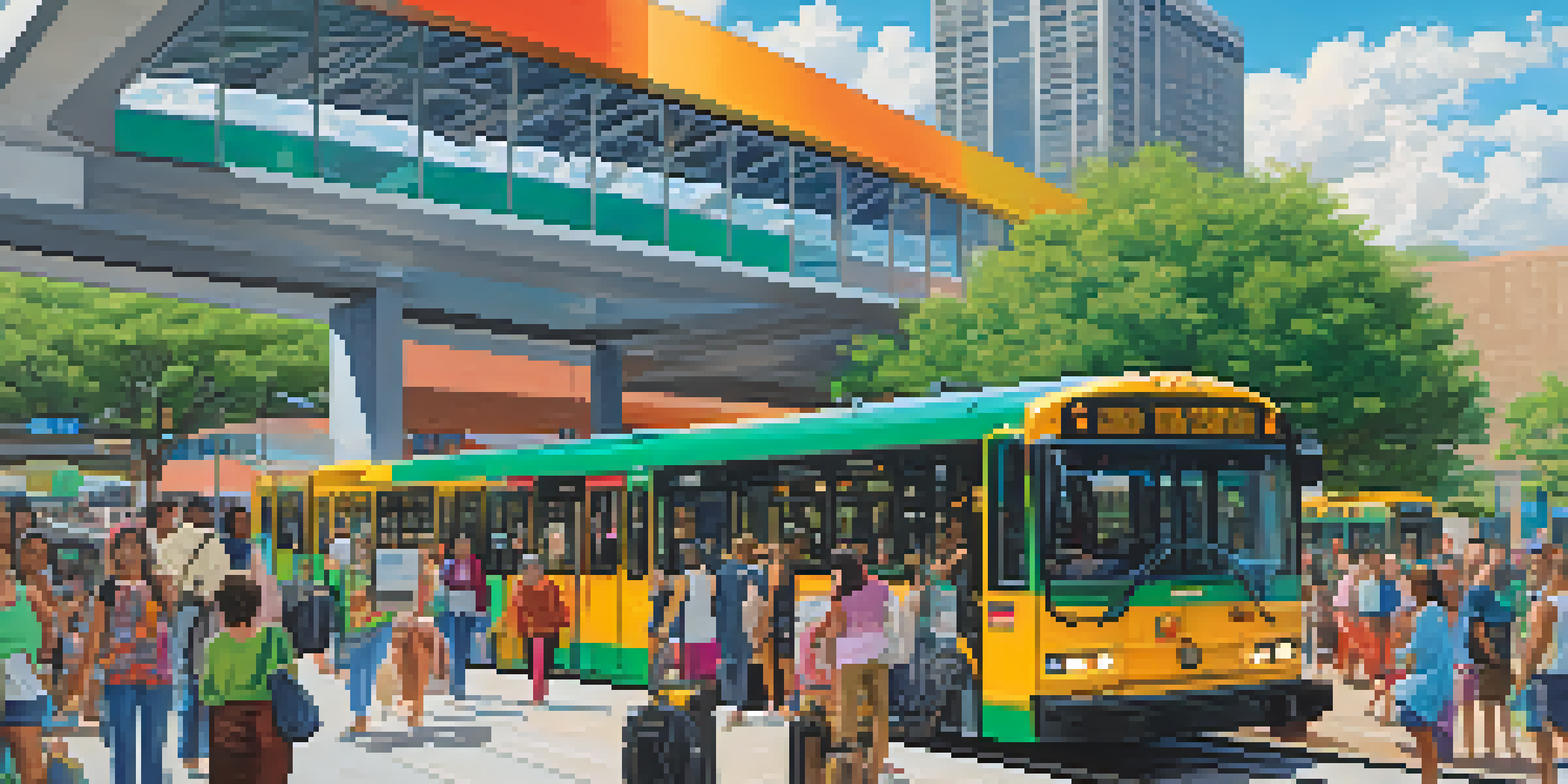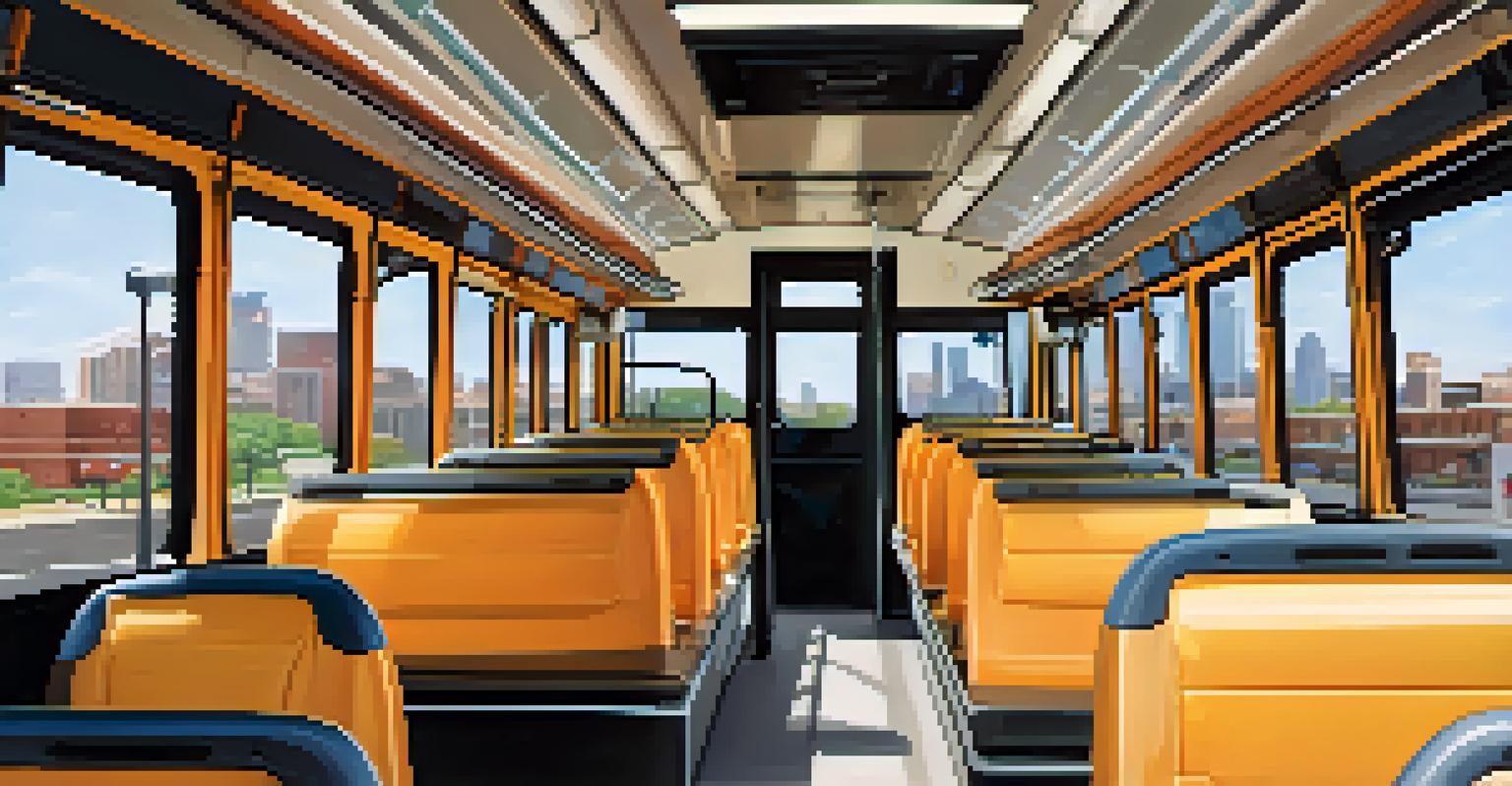Transportation Accessibility: Dallas Public Transit Innovations

Understanding Transportation Accessibility in Dallas
Transportation accessibility refers to the ease with which all individuals can use public transit systems. In Dallas, this means ensuring that everyone, including those with disabilities, the elderly, and low-income residents, can access the city’s transportation network without barriers. Achieving this goal not only promotes inclusivity but also enhances the overall quality of life for residents.
Transportation is not just about getting from one place to another; it’s about ensuring everyone has the opportunity to participate in their community.
In recent years, Dallas has recognized the importance of making public transit accessible for all. This commitment is reflected in various initiatives aimed at improving infrastructure, services, and user experience. By addressing the diverse needs of its population, the city is paving the way for a more equitable transportation system.
For instance, the Dallas Area Rapid Transit (DART) has been actively working to identify and eliminate obstacles that hinder access for vulnerable populations. By focusing on these efforts, Dallas is setting an example for other cities striving to create more accessible public transit options.
Recent Innovations in Dallas Public Transit
Dallas has embraced a number of innovative technologies to enhance public transit accessibility. One notable example is the introduction of mobile apps that provide real-time information about transit schedules and routes. These apps empower riders to plan their journeys more effectively, minimizing wait times and improving overall convenience.

Additionally, DART has implemented features such as audio announcements and visual displays at transit stops. These enhancements ensure that all riders, particularly those with visual or hearing impairments, receive the information they need to navigate the system confidently. Such innovations reflect a commitment to accommodating the diverse needs of the community.
Dallas Prioritizes Transit Accessibility
The city is committed to ensuring that public transit is accessible for all residents, including those with disabilities and low-income individuals.
Moreover, the city’s investment in electric buses not only promotes sustainability but also improves accessibility. These buses are designed to be more user-friendly, featuring low floors and ramps that make boarding easier for individuals with mobility challenges.
Community Engagement: Shaping Future Projects
Community engagement plays a crucial role in shaping transportation accessibility initiatives in Dallas. By involving residents in the decision-making process, the city can better understand their needs and preferences. This collaborative approach fosters a sense of ownership among citizens, ultimately leading to more successful transit solutions.
Accessibility is not a feature, it’s a social imperative.
DART regularly conducts surveys and holds public meetings to gather feedback from riders. These insights are invaluable for identifying areas of improvement and potential projects that could enhance accessibility. By listening to the voices of the community, Dallas is better equipped to implement changes that truly reflect the needs of its residents.
Furthermore, partnerships with local organizations dedicated to disability rights have proven beneficial. These collaborations help DART to gain deeper insights into the challenges faced by individuals with disabilities, ensuring that future innovations are both effective and empathetic.
Impact of COVID-19 on Public Transit Accessibility
The COVID-19 pandemic has significantly impacted public transit systems worldwide, and Dallas is no exception. During this period, DART implemented safety measures that also affected accessibility. For example, social distancing protocols led to reduced capacity on buses and trains, which posed challenges for riders who rely on public transit for essential travel.
However, the pandemic also accelerated the adoption of contactless payment systems, which enhance accessibility for all riders. By allowing users to pay through mobile devices or preloaded cards, DART has made it easier for individuals to board transit without physical contact. This innovation not only improves convenience but also promotes health and safety in the wake of the pandemic.
Innovative Solutions Enhance Transit
Technological advancements, such as mobile apps and real-time tracking, are improving the public transit experience for users in Dallas.
As the city navigates the post-pandemic landscape, there is an opportunity to reassess and enhance accessibility features. Lessons learned during this time can inform future strategies to create a more resilient and accessible public transit system that meets the evolving needs of Dallas residents.
Funding and Investments in Transit Innovations
Funding is a vital component in advancing transportation accessibility in Dallas. The city has secured numerous grants and federal funding aimed at enhancing public transit infrastructure. These financial resources allow DART to invest in necessary upgrades, including accessible facilities and vehicles.
Local government support has also played a significant role in prioritizing transit innovations. By committing to budget allocations for accessibility projects, Dallas is demonstrating a clear intention to create a more inclusive transportation network. This proactive approach sets a foundation for sustainable growth and improvement in public transit services.
Moreover, public-private partnerships are emerging as a promising strategy to bolster funding. Collaborations with tech companies and other stakeholders can lead to innovative solutions and shared resources, ultimately enhancing the overall accessibility of Dallas's public transit system.
The Role of Technology in Enhancing Accessibility
Technology is a powerful tool in making public transit more accessible, and Dallas is leveraging its potential. For instance, GPS tracking systems allow riders to see the location of buses in real-time, reducing uncertainty and wait times. This technology is particularly beneficial for individuals who may have difficulty navigating complex schedules.
Additionally, DART has invested in automated announcements and digital signage at transit stops, which provide crucial information for all users. These advancements not only improve the experience for riders with disabilities but also enhance usability for everyone. Clear communication is essential in fostering a user-friendly transit environment.
Community Involvement Drives Change
Engaging the community in decision-making processes is essential for Dallas to address the diverse needs of its residents in transit planning.
As technology continues to evolve, Dallas is committed to staying ahead of the curve. By exploring emerging solutions like artificial intelligence and smart mobility options, the city can ensure that its public transit system remains accessible and efficient for all.
Future Vision for Accessible Public Transit in Dallas
Looking ahead, Dallas has ambitious plans for further enhancing transportation accessibility. The city aims to create a fully integrated transit network that seamlessly connects various modes of transportation, including buses, trains, and rideshare options. This vision is centered around providing a comprehensive solution that meets the diverse needs of all residents.
In addition to infrastructure improvements, ongoing community engagement will remain a priority. By continually soliciting feedback and adapting to changing needs, Dallas can ensure that its public transit system evolves alongside its population. This dynamic approach fosters a sense of inclusivity and empowers residents to advocate for their transportation needs.

Ultimately, the goal is to create a public transit system that not only meets current accessibility standards but sets a benchmark for other cities. With strategic planning, innovative solutions, and a commitment to community involvement, Dallas is poised to lead the way in transportation accessibility.